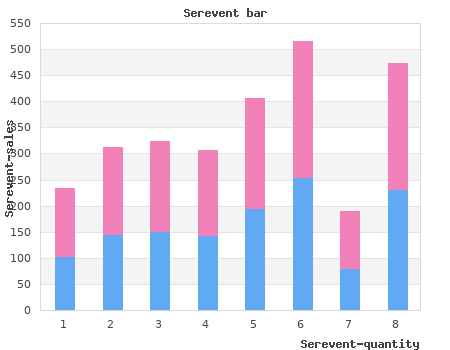By O. Vasco. Virginia University of Lynchburg. 2017.
Clinical Associate Professor buy serevent 25 mcg free shipping, Department of Physical Medicine and Rehabilitation order serevent 25mcg with visa, University of Medicine and Dentistry of New Jersey—Robert Wood Johnson Medical School, Associate Medical Director, Director of Inpatient Services, Medical Director, Center for Head Injury, JFK Johnson Rehabilitation Institute, Edison, New Jersey Matthew Raymond, D. Diplomate, American Board of Physical Medicine and Rehabilitation; Attending Physiatrist, Musculoskeletal Medicine, Gaylord Hospital, Wallingford, Connecticut Thomas E. Introduction 1 Basic Neuroanatomic Review of the Major Vessels Involved in Stroke 3 Types of Stroke 6 Diagnostic Studies 17 Treatment 19 Stroke Rehabilitation 25 2. Introduction 47 Mechanism and Recovery of Head Injury 48 Disorders of Consciousness 52 Posturing Secondary to Head Injury 54 Predictors of Outcome After TBI 55 Medical Complications After TBI 63 Mild Traumatic Brain Injury and Postconcussive Syndrome 76 3. Rheumatoid Arthritis (RA) 81 Osteoarthritis (OA) 94 Juvenile Rheumatoid Arthritis (JRA) 98 Juvenile Spondyloarthropathies 100 Crystal Induced Synovitis 102 Seronegative Spondyloarthropathies 104 CTD (Connective Tissue Disorders) and Systemic Arthritic Disorders 111 Vasculitis 115 Sjögren’s Syndrome 116 xv xvi CONTENTS Arthritis and Infectious Disorders 117 Deposition and Storage Disease 119 Other Systemic Diseases 120 Neuropathic Arthropathy (Charcot’s Joint) 121 Fibromyalgia Syndrome (FMS) 124 Complex Regional Pain Disorder (CRPD) 125 Tendon Disorders 127 4. Upper Extremities—Shoulder Region 131 Shoulder Disorders 138 Upper Extremities—Elbow Region 160 Elbow Disorders 163 Upper Extremities—Wrist Region 174 Wrist Disorders 177 Upper Extremities—Hand Region 182 Hand Disorders 186 Lower Extremities—Hip 191 Hip Disorders 199 Lower Extremities—The Knee 210 Knee Disorders 221 Lower Extremities—The Lower Leg 230 Disorders of the Lower Leg 232 Lower Extremity—Ankle and Foot Region 237 Disorders of the Ankle 240 Foot Disorders 251 Toe Disorders: Hammer, Claw, and Mallet 253 Spine Rehabilitation 256 Disc Disorders 268 Bone Disorders of the Spine 276 Joint Disorders of the Spine 286 Other Infectious Disorders of the Spine 290 5. Introduction 295 Pathophysiology 311 Nerve Conduction Studies (NCS) 315 Somatosensory Evoked Potentials (SSEP) 326 Basic Needle EMG 328 Upper Limb Mononeuropathy 351 Lower Limb Mononeuropathy 371 CONTENTS xvii Peripheral Neuropathy 382 Neuromuscular Junction Disorders 390 Myopathy 397 Motor Neuron Disease 404 6. Gait Analysis 409 Prosthetics 416 Assistive Devices—Ambulation Aids 458 Shoes and Lower Limb Orthoses 460 Orthotics 466 Upper Limb Orthotics 473 Spinal Orthoses 481 7. Epidemiology of Spinal Cord Injury (SCI) 489 Anatomy 490 Spinal Pathology 494 Classification of SCI 500 Medical Complications of SCI 512 Pain in the SCI Patient 545 Pressure Ulcers 547 8. PHYSICAL MODALITIES, THERAPEUTIC EXERCISE, EXTENDED BEDREST, AND AGING EFFECTS. Physical Modalities 553 Therapeutic Exercise 570 Effects of Extended Bedrest—Immobilization and Inactivity 576 Evaluation of Functional Independence 578 Physiologic Effects of Aging 580 9. Pulmonary Rehabilitation 585 Cardiac Rehabilitation 610 Cancer Rehabilitation 628 10. Genetics and Chromosomal Abnormalities 645 Development and Growth 647 xviii CONTENTS Pediatric Limb Deficiencies 653 Diseases of the Bones and Joints 658 Connective Tissue and Joint Disease 669 Pediatric Burns 680 Pediatric Cancers 685 Traumatic Brain Injury (TBI) 688 Cerebral Palsy (CP) 693 Spina Bifida 712 Neuromuscular Disease in Children 721 11. Spasticity 743 Movement Disorders 750 Wheelchairs 759 Multiple Sclerosis (MS) 770 Osteoporosis 777 Rehabilitation of Burn Injuries 791 EPILOGUE. PREFACE The Physical Medicine and Board Review Book will appeal to medical students, residents, and practicing physiatrists.

There are also cells here that respond to only thresholds are usually unchanged distant from the chemical stimulation discount serevent 25 mcg mastercard, including histamine release in injury site purchase serevent 25 mcg with mastercard. A small population of One such cascade includes Ca2+ activation of nociception-specific cells are located in the deep dor- the enzyme phospholipase A2 (PLA2); this frees sal horn. This “classical” pathway projects to cyclooxygenase and results in the production of somatosensory (S1) cortex and is postulated to be prostaglandins. Prostaglandins (PGs) diffuse out of integral in sensory discrimination of pain, that is, the spinal neurons and back to the central terminal of where is it, is it sharp, is it hot, and so on. There, they act on specific PG receptors to posterior thalamus (VMpo); this nucleus, in turn, increase the amount of neurotransmitter released per projects to posterior insula cortex. Other recently been proposed to be a unique cortical pain enzymes, including nitric oxide synthase, are acti- center as well as to be involved in homeostatic control vated by Ca2+ in a similar manner, also resulting in a of the internal environment, including tissue integrity. This alternative hypothesis proposes that dorsal pos- Prostaglandins also act via specific PG receptors on terior insula rather than S1 cortex is the primary focus astrocytes to activate them and cause them to release of the sensory-discriminative aspect of pain. This area projects to the anterior cingulate that use of local anesthetics around the incision cortex. This medial pathway is likely to represent the (injury site) would block the high-frequency C-fiber motivational affective component of pain. Studies with maintained peripheral blockade of afferent input are under way. They bind to µ and κ opiate receptors on the central terminal of nociceptive pri- mary afferent fibers (presynaptic) and, by reducing Sorkin LS, Wallace MS. Surg Ca2+ entry when the action potential invades the ter- Clin North Am. Pain: Nociceptive and cally (on the dorsal horn neurons) to µ and δ opiate neuropathic mechanisms with clinical correlates. Aβ Yaksh TL, Lynch C, Zapol WM, Maze M, Biebuyck JF, fibers do not have presynaptic opiate receptors. This is one theory of why Aβ-mediated pain is relatively opiate resistant. Yaksh, PhD monoamines are released primarily from axons whose cell bodies are located in various branstem nuclei.

If corneal protectors are used instead generic 25mcg serevent amex, three traction stitches should be placed on the lid margin discount 25 mcg serevent with visa. Hemostasis is carefully performed before moving to the next area (see next section on Hemostasis). The Goulian dermatome with the 8/1000 guard is used on the nasal pyramid. The nasal pyramid is well supported and the excision proceeds in the standard fashion. When normal tissue is observed, the excision must be stopped even if vitality is in question. Countertraction is necessary for the lips in a similar fashion to the excision of eyelids. The tissue of the philtrum and philtral columns should be managed similarly to the tip of the nose and nares. This allows for a good contour of the philtral area when skin grafts are applied. The areas that are left behind can be excised anew during the second-stage procedure, which permits a better outcome. If they are overexcised until briskpulsatile bleeding is observed, a flat lip may result, requiring difficult reconstructive procedures in the future to provide anatomical reconstruction. The Goulian dermatome with the 8/1000 guard is used again to excise the chin. It is imperative to preserve as much tissue as possible on the mental prominence to avoid a flat chin that would require future reconstruction.

Complications One essential requirement is the radiological recording Growth disturbances are not known buy serevent 25mcg mastercard. Patella alta and of deformities discount serevent 25 mcg with amex, particularly varus or valgus deformities, as calcification of the patellar ligament can occur after over- experience has shown that these are poorly corrected by looked or inadequately refixed inferior pole avulsions. The requirement that the shaft of the lower leg Femoropatellar arthrosis after fractures with incongruent should be perpendicular to the tibial plateau can easily be consolidation or after partial patellectomy are possible checked by the angle of the epiphyseal axis (⊡ Fig. On the lateral view, the tibial plateau normally slopes in the posterior direction at an angle of approx. This is primarily attributable to the finding on the bone scan is local hyperactivity, while fact that this region is mechanically well protected: later- the CT scan shows perifocal edema in the soft tissue ally by the fibula, ventrally by the tuberosity and patellar ligament, medially by the growth plate-bridging medial collateral ligament and posteromedially by the attachment of the semimembranosus muscle. The growth plate of the proximal tibia projects anteri- orly like a tongue into that below the tibial tuberosity. This plate section is exposed to traction forces produced by the patellar ligament, which is inserted at this point, and can thus be considered as an apophysis from the functional standpoint. In physiological respects, these anterior sec- tions are the last to undergo physeal closure towards the end of growth. Diagnosis Clinical features The tibial head (and thus the proximal epiphysis and metaphysis) is readily inspected and palpated, at least in its anterior sections, thanks to the thin soft tissue cover- ing. Epiphyseal fractures usually lead to hemarthrosis, while metaphyseal fractures, in contrast with the cor- ⊡ Fig. The size is Fractures of the intercondylar eminence correspond to frequently underestimated on the x-ray because of the bony avulsions of the distal anterior cruciate ligament cartilaginous section. Epiphyseal fractures (Salter-Harris types III and IV – The accident mechanism in such cases corresponds to chapter 4. They hemarthrosis and increased anterior tibial translation in occur predominantly during adolescence. The latter is the most sensitive test for ligament lesions or menisci trapped in the fracture gap anterior cruciate ligament lesions: The anterior transla- are often identified only secondarily or during surgical tion of the tibia is tested in the supine patient at approx. The ligaments should not be tested, Compression fractures are stable, are not associated however, after recent trauma, partly because this is a pain- with any misalignment and heal without complications.




